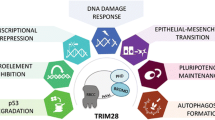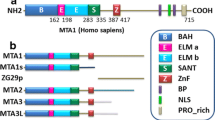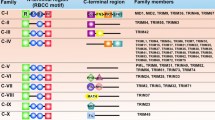Abstract
TMS1/ASC is a bipartite protein comprising two protein-protein interaction domains, a pyrin domain (PYD) and a caspase recruitment domain (CARD). Proteins containing these domains play pivotal roles in regulating apoptosis and immune response pathways, and mutations in a number of PYD- and CARD-containing proteins have been linked to autoinflammatory diseases and cancer. Indeed, one of the ways in which TMS1/ASC was identified was as a target of methylation-mediated silencing in breast cancer cells. This review discusses the mounting evidence supporting a correlation between the silencing of TMS1/ASC expression and cancer. In addition, it addresses the reported functions of TMS1/ASC that include apoptosis, activation of inflammatory caspases and regulation of NF-kappa B, and discusses the potential ways in which loss of TMS1/ASC contributes to carcinogenesis.
Similar content being viewed by others
References
Martinon F, Hofmann K, Tschopp J. The pyrin domain: A possible member of the death domain-fold family implicated in apoptosis and inflammation. Curr Biol 2001; 11: R118–R120.
Fairbrother WJ, Gordon NC, Humke EW, et al. The PYRIN domain: A member of the death domain-fold superfamily. Protein Sci 2001; 10: 1911–1918.
Staub E, Dahl E, Rosenthal A. The DAPIN family: A novel domain links apoptotic and interferon response proteins. Trends Biochem Sci 2001; 26: 83–85.
Pawlowski K, Pio F, Chu Z, Reed JC, Godzik A. PAAD-A new protein domain associated with apoptosis, cancer and autoimmune diseases. Trends Biochem Sci 2001; 26: 85–87.
Weber CH, Vincenz C. The death domain superfamily: A tale of two interfaces? Trends Biochem Sci 2001; 26: 475–481.
Martin SJ. Dealing the CARDs between life and death. Trends Cell Biol 2001; 11: 188–189.
Conway KE, McConnell BB, Bowring CE, Donald CD, Warren ST, Vertino PM. TMS1, a novel proapoptotic caspase recruitment domain protein, is a target of methylation-induced gene silencing in human breast cancers. Cancer Res 2000; 60: 6236–6242.
DeYoung KL, Ray ME, Su YA, et al. Cloning a novel member of the human interferon-inducible gene family associated with control of tumorigenicity in a model of human melanoma. Oncogene 1997; 15: 453–457.
Kastner DL, O'Shea JJ. A fever gene comes in from the cold. Nat Genet 2001; 29: 241–242.
Willis TG, Jadayel DM, Du MQ, et al. Bcl10 is involved in t(1;14)(p22;q32) of MALT B cell lymphoma and mutated in multiple tumor types. Cell 1999; 96: 35–45.
Zhang Q, Siebert R, Yan M, et al. Inactivating mutations and overexpression of BCL10, a caspase recruitment domain-containing gene, in MALT lymphoma with t(1;14)(p22;q32). Nat Genet 1999; 22: 63–68.
Masumoto J, Taniguchi S, Ayukawa K, et al. ASC, a novel 22-kDa protein, aggregates during apoptosis of human promyelocytic leukemia HL-60 cells. J Biol Chem 1999; 274: 33835–33838.
Martinon F, Burns K, Tschopp J. The inflammasome: A molecular platform triggering activation of inflammatory caspases and processing of proIL-beta. Mol Cell 2002; 10: 417–426.
Manji GA, Wang L, Geddes BJ, et al. PYPAF1, a PYRIN-containing Apaf1-like protein that assembles with ASC and regulates activation of NF-kappa B. J Biol Chem 2002; 277: 11570–11575.
Srinivasula SM, Poyet JL, Razmara M, Datta P, Zhang Z, Alnemri ES. The PYRIN-CARD protein ASC is an activating adaptor for caspase-1. J Biol Chem 2002; 277: 21119–21122.
Moriai R, Tsuji N, Kobayashi D, et al. A proapoptotic caspase recruitment domain protein gene, TMS1, is hypermethylated in human breast and gastric cancers. Anticancer Res 2002; 22: 4163–4168.
Virmani A, Rathi A, Sugio K, et al. Aberrant methylation of TMS1in small cell, non small cell lung cancer and breast cancer. Int J Cancer 2003; 106: 198–204.
Guan X, Sagara J, Yokoyama T, et al. ASC/TMS1, a caspase-1 activating adaptor, is downregulated by aberrant metylation in human melanoma. Int J Cancer 2003; 107: 202–208.
Bird AP. CpG-rich islands and the function of DNA methylation. Nature 1986; 321: 209–213.
Antequera F, Bird A. CpG islands. Exs 1993; 64: 169–185.
Lander ES, Linton LM, Birren B, et al. Initial sequencing and analysis of the human genome. Nature 2001; 409: 860–921.
Keshet I, Yisraeli J, Cedar H. Effect of regional DNA methylation on gene expression. Proc Natl Acad Sci U S A 1985; 82: 2560–2564.
Cross SH, Bird AP. CpG islands and genes. Curr Opin Genet Dev 1995; 5: 309–314.
Wigler M, Levy D, Perucho M. The somatic replication of DNA methylation. Cell 1981; 24: 33–40.
Baylin SB, Herman JG, Graff JR, Vertino PM, Issa JP. Alterations in DNA methylation:Afundamental aspect of neoplasia. Adv Cancer Res 1998; 72: 141–196.
Jones PA, Laird PW. Cancer epigenetics comes of age. Nat Genet 1999; 21: 163–167.
Bachman KE, Herman JG, Corn PG, et al. Methylation-associated silencing of the tissue inhibitor of metalloproteinase-3 gene suggest a suppressor role in kidney, brain, and other human cancers. Cancer Res 1999; 59: 798–802.
Esteller M, Corn PG, Baylin SB, Herman JG. A gene hypermethylation profile of human cancer. Cancer Res 2001; 61: 3225–3229.
van't Veer LJ, Dai H, van de Vijver MJ, et al. Gene expression profiling predicts clinical outcome of breast cancer. Nature 2002; 415: 530–536.
Schmitt AO, Specht T, Beckmann G, et al. Exhaustive mining of EST libraries for genes differentially expressed in normal and tumour tissues. Nucleic Acids Res 1999; 27: 4251–4260.
Levine JJ, Stimson-Crider KM, Vertino PM. Effects of methylation on expression of TMS1/ASC in human breast cancer cells. Oncogene 2003; 22: 3475–3488.
Masumoto J, Taniguchi S, Nakayama J, et al. Expression of apoptosis-associated speck-like protein containing a caspase recruitment domain, a pyrin N-terminal homology domain-containing protein, in normal human tissues. J Histochem Cytochem 2001; 49: 1269–1275.
Zhou P, Chou J, Olea RS, Yuan J, Wagner G. Solution structure of Apaf-1 CARD and its interaction with caspase-9 CARD: A structural basis for specific adaptor/caspase interaction. Proc Natl Acad Sci USA 1999; 96: 11265–11270.
Chou JJ, Matsuo H, Duan H, Wagner G. Solution structure of the RAIDD CARD and model for CARD/CARD interaction in caspase-2 and caspase-9 recruitment. Cell 1998; 94: 171–180.
Inohara N, Nunez G. NODs: Intracellular proteins involved in inflammation and apoptosis. Nat Rev Immunol 2003; 3: 371–382.
Deveraux QL, Reed JC. IAP family proteins-suppressors of apoptosis. Genes Dev 1999; 13: 239–252.
Inohara N, del Peso L, Koseki T, Chen S, Nunez G. RICK, a novel protein kinase containing a caspase recruitment domain, interacts with CLARP and regulates CD95-mediated apoptosis. J Biol Chem 1998; 273: 12296–12300.
Thome M, Hofmann K, Burns K, et al. Identification of CARDIAK, a RIP-like kinase that associates with caspase-1. Curr Biol 1998; 8: 885–888.
McCarthy JV, Ni J, Dixit VM. RIP2 is a novel NF-kappaB-activating and cell death-inducing kinase. J Biol Chem 1998; 273: 16968–16975.
Duan H, Dixit VM. RAIDD is a new 'death' adaptor molecule. Nature 1997; 385: 86–89.
Masumoto J, Zhou W, Chen FF, et al. Caspy, a zebrafish caspase, activated by ASC oligomerization is required for pharyngeal arch development. J Biol Chem 2003; 278: 4268–4276.
Bertin J, Nir WJ, Fischer CM, et al. Human CARD4 protein is a novel CED-4/Apaf-1 cell death family member that activates NF-kappaB. J Biol Chem 1999; 274: 12955–12958.
Srinivasula SM, Ahmad M, Lin JH, et al. CLAP, a novel caspase recruitment domain-containing protein in the tumor necrosis factor receptor pathway, regulates NF-kappaB activation and apoptosis. J Biol Chem 1999; 274: 17946–17954.
Inohara N, Koseki T, del Peso L, et al. Nod1, an Apaf-1-like activator of caspase-9 and nuclear factor-kappaB. J Biol Chem 1999; 274: 14560–14567.
Bertin J, Guo Y, Wang L, et al. CARD9 is a novel caspase recruitment domain-containing protein that interacts with BCL10/CLAP and activates NF-kappa B. J Biol Chem 2000; 275: 41082–41086.
Ogura Y, Inohara N, Benito A, Chen FF, Yamaoka S, Nunez G. Nod2, a Nod1/Apaf-1 family member that is restricted to monocytes and activates NF-kappaB. J Biol Chem 2001; 276: 4812–4818.
Anonymous. Ancient missense mutations in a new member of the RoRet gene family are likely to cause familial Mediterranean fever. The International FMF Consortium. Cell 1997; 90: 797–807.
Hoffman HM, Wright FA, Broide DH, Wanderer AA, Kolodner RD. Identification of a locus on chromosome 1q44 for familial cold urticaria. Am J Hum Genet 2000; 66: 1693–1698.
Cuisset L, Drenth JP, Berthelot JM, et al. Genetic linkage of the Muckle-Wells syndrome to chromosome 1q44. Am J Hum Genet 1999; 65: 1054–1059.
Grenier JM, Wang L, Manji GA, et al. Functional screening of five PYPAF family members identifies PYPAF5 as a novel regulator of NF-kappaB and caspase-1. FEBS Lett 2002; 530: 73–78.
Tibbetts MD, Zheng L, Lenardo MJ. The death effector domain protein family: Regulators of cellular homeostasis. Nat Immunol 2003; 4: 404–409.
Hofmann K, Bucher P, Tschopp J. The CARD domain: A new apoptotic signalling motif. Trends Biochem Sci 1997; 22: 155–156.
McConnell BB, Vertino PM. Activation of a caspase-9-mediated apoptotic pathway by subcellular redistribution of the novel caspase recruitment domain protein TMS1. Cancer Res 2000; 60: 6243–6247.
Masumoto J, Taniguchi S, Sagara J. Pyrin N-terminal homology domain-and caspase recruitment domain-dependent oligomerization of ASC. Biochem Biophys Res Commun 2001; 280: 652–655.
Richards N, Schaner P, Diaz A, et al. Interaction between pyrin and the apoptotic speck protein (ASC) modulates ASC-induced apoptosis. J Biol Chem 2001; 276: 39320–39329.
Wang L, Manji GA, Grenier JM, et al. PYPAF7, a novel PYRIN-containing Apaf1-like protein that regulates activation of NF-kappa B and caspase-1-dependent cytokine processing. J Biol Chem 2002; 277: 29874–29880.
Garvey T, Bertin J, Siegel R, Lenardo M, Cohen J. The death effector domains (DEDs) of the molluscum contagiosum virus MC159 v-FLIP protein are not functionally interchangeable with each other or with the DEDs of caspase-8. Virology 2002; 300: 217–225.
Shearwin-Whyatt LM, Harvey NL, Kumar S. Subcellular localization and CARD-dependent oligomerization of the death adaptor RAIDD. Cell Death Differ 2000; 7: 155–165.
Lowe SW, Lin AW. Apoptosis in cancer. Carcinogenesis 2000; 21: 485–495.
Frisch SM, Ruoslahti E. Integrins and anoikis. Curr Opin Cell Biol 1997; 9: 701–706.
Geddes BJ, Wang L, Huang WJ, et al. Human CARD12 is a novel CED4/Apaf-1 family member that induces apoptosis. Biochem Biophys Res Commun 2001; 284: 77–82.
Masumoto J, Dowds TA, Schaner P, et al. ASC is an activating adaptor for NF-kappa B and caspase-8-dependent apoptosis. Biochem Biophys Res Commun 2003; 303: 69–73.
Dowds TA, Masumoto J, Chen FF, Ogura Y, Inohara N, Nunez G. Regulation of cryopyrin/Pypaf1 signaling by pyrin, the familial Mediterranean fever gene product. Biochem Biophys Res Commun 2003; 302: 575–580.
Ghosh S, May MJ, Kopp EB. NF-kappaB and Rel proteins: Evolutionarily conserved mediators of immune responses. Annu Rev Immunol 1998; 16: 225–260.
Karin M, Cao Y, Greten FR, Li ZW. NF-kappaB in cancer: from innocent bystander to major culprit. Nat Rev Cancer 2002; 2: 301–310.
Li Q, Verma IM. NF-kappaB regulation in the immune system. Nat Rev Immunol 2002; 2: 725–734.
Ghosh S, Karin M. Missing pieces in the NF-kappaB puzzle. Cell 2002; 109(Suppl): S81–96.
Stehlik C, Fiorentino L, Dorfleutner A, et al. The PAAD/PYRIN-family protein ASC is a dual regulator of a conserved step in nuclear factor kappaB activation pathways. J Exp Med 2002; 196: 1605–1615.
Zeuner A, Eramo A, Peschle C, De Maria R. Caspase activation without death. Cell Death Differ 1999; 6: 1075–1080.
Poyet JL, Srinivasula SM, Tnani M, Razmara M, Fernandes-Alnemri T, Alnemri ES. Identification of Ipaf, a human caspase-1-activating protein related to Apaf-1. J Biol Chem 2001; 276: 28309–28313.
Shiohara M, Taniguchi S, Masumoto J, et al. ASC, which is composed of a PYD and a CARD, is up-regulated by inflammation and apoptosis in human neutrophils. Biochem Biophys Res Commun 2002; 293: 1314–1318.
Chu ZL, Pio F, Xie Z, et al. A novel enhancer of the Apaf1 apoptosome involved in cytochrome c-dependent caspase activation and apoptosis. J Biol Chem 2001; 276: 9239–9245.
Hall PA, Coates PJ, Ansari B, Hopwood D. Regulation of cell number in the mammalian gastrointestinal tract: The importance of apoptosis. J Cell Sci 1994; 107: 3569–3577.
Hlaing T, Guo RF, Dilley KA, et al. Molecular cloning and characterization of DEFCAP-L and-S, two isoforms of a novel member of the mammalian Ced-4 family of apoptosis proteins. J Biol Chem 2001; 276: 9230–9238.




